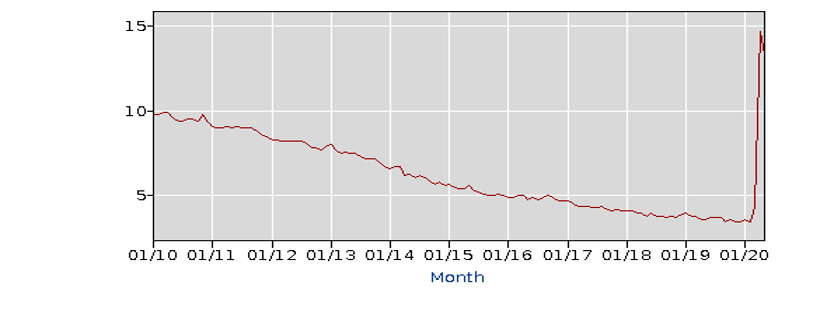
Before the onset of the coronavirus, the United States enjoyed its longest period of economic growth in history – beginning in 2010 and ending in 2020. During that period some things stayed the same, and some things didn’t. This blog series will take a look at what happened to some key economic factors over that period. But first, a quick review on the economic recovery of the last decade.
Following the financial crisis and recessions of 2008 and 2009, the economy began to recover in 2010. A fiscal stimulus, improving credit conditions, temporarily reduced social security taxes (2011 and 2012), record low interest rates, and a calming of the financial markets all contributed to the turnaround. The graph below shows the unemployment rate over the past decade. After peaking at approximately 10% in October 2009 the unemployment rate took a long, gradual decline until the spike in early 2020. In 2018 the unemployment rate dipped below 4%, which had not occurred since 1970. The 2018 tax cuts contributed to the continuation of a relatively long period of economic growth but also contributed to growing federal deficits in a period of economic expansion.
Unemployment Rate (16 yrs. and older)

Mirroring the declining unemployment rate was GDP growth. Economic growth was by no means stellar; it was a prolonged period of steady growth, with annual growth never exceeding 3.0% during the recent recovery. In the economic recovery of 1992–2000, economic growth exceeded 3.0% in 7 out of 9 years and was 4.0% or greater in 5 years. In the economic recovery after 2001, economic growth exceeded 3.0% in 2004 and 2005.

According to the National Bureau of Economic Research the recent economic recovery was the longest in history and reached 128 months in February 2020 before coming to a screeching halt. The longest economic recovery in history – what changed other than unemployment and economic growth? We’ll discuss the impact of the economic recovery on a few select variables next.
For further information:
- Unemployment Rate Data from the Bureau of Labor Statistics: Bureau of Labor Statistics
- GDP Growth (and other national data) from the Bureau of Economic Analysis: GDP Growth
- Info on Economic cycles from the National Bureau of Economic Research: Economic Cycles

CBEI Series: The Economic Recovery 2010-19: What Changed and What Didn’t
Part 1: Overview
Part 2: Wealth Distribution
Part 3: Manufacturing Employment
Part 4: Trade with China … and the Rise of Vietnam
Part 5: Funding the U.S. Government – Corporate vs. Individual Taxes
Part 6: Corporate Debt and Collateralized Loan Obligations

Kevin Bahr is a professor emeritus of finance and chief analyst of the Center for Business and Economic Insight in the Sentry School of Business and Economics at the University of Wisconsin-Stevens Point.
